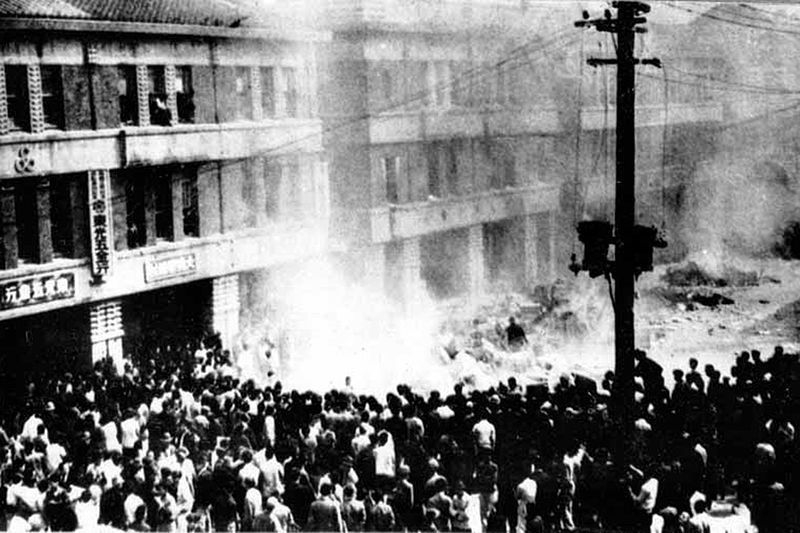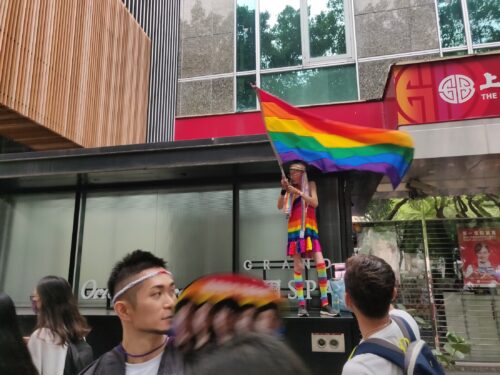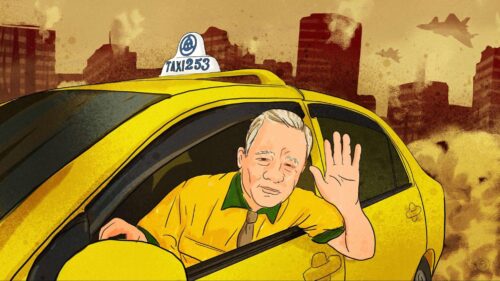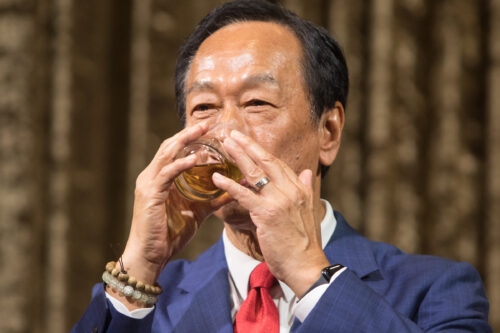This Week in China’s History: February 28, 1947
On the evening of February 27, 1947, 40-year-old Lín Jiāngmài 林江邁 was selling cigarettes in a Taipei teahouse. Tobacco was a government monopoly and an important source of revenue for the Nationalist government that had taken over administration of the island in 1945, and the Monopoly Enforcement Bureau was responsible for enforcing the monopoly.
The bureau had received a tip earlier that day that a shipment of illegal cigarettes had made its way to the Tianma Teahouse, in a part of the city long associated with smugglers. Ten agents were dispatched to investigate and interdict the illegal trade. That evening, six investigators and four uniformed officers entered the teahouse, but the alleged smugglers had fled. Finding only Lin Jiangmai, the agents demanded that she surrender her cigarettes. When Lin protested that she relied on the sales to support herself, one of the officers hit her in the head with a pistol butt, leaving her bleeding. Another officer fired into the crowd, striking a bystander, who later died.
Outraged, the crowd in and around the teahouse surrounded the government agents, calling for the head of the man who fired the shot. The 10 men managed to escape on foot; the vehicle they left behind was set alight. When additional officers arrived to investigate, their car was surrounded and forced back to the police station, where soon more than 600 people had assembled. Refusing to disperse, the crowd grew in size and intensity through the night.
The next morning, February 28, mobs gathered in several parts of the city. Some asked shopkeepers along the main thoroughfare, Taiping Street, to close their shops. When a police officer fired in the air to disperse the crowd, he was surrounded and beaten. The mob occupied the precinct house, smashing windows and destroying equipment. They beat two monopoly officials to death and repulsed attempts by Nationalist troops to restore order.
The crowd directed its wrath not just at officials of the Nationalist government, but at anyone perceived to be a mainlander. Journalist Wang Kang, observing events from his hotel room, wrote: “Just at that moment, a passenger train had disgorged its passengers. Some of them, Mainlanders, had just emerged from the railway station only to be beaten severely; many were wounded and others killed…There were two military men dressed in their uniforms strolling hand in hand down the street. They were quickly surrounded by Taiwanese who used their fists and rocks to beat them.”
The attacks on mainlanders can be further elaborated by a small gesture amid all the violence, anger, and destruction, on the morning of February 28. As crowds assembled to begin what would become weeks of protest and rebellion, some people targeted storefront signs. As Lai Tse-han, Ramon Myers, and Wu Wou wrote in their book A Tragic Beginning, “characters for ‘China’ had been removed from signs on the China Hotel and the Bank of China, and a banner in Japanese appeared reading ‘Down with Military Tyranny!’”
Recent debates over Taiwan’s identity as Chinese, or part of China, focus on the awkward arrangement by which governments in Taipei and Beijing both claim sovereignty over the island. The “One China” policy presents reality-defying spectacles, most recently when Taiwanese athletes competed in the Winter Olympics (despite the island’s tropical climate, four athletes from Taiwan competed in alpine skiing, luge, and speed skating), but without the national flag or official nationality found on their passports.
In 1947, questions of national identity and political affiliation were also rampant in Taiwan, but the fault lines were very different. Japan had taken control of the island in 1895: a colonial possession won in a war with Qing China. For the next 50 years, Taiwan was a Japanese colony; Japanese rule and customs had been imposed on the island, and Taiwan was integrated into the imperial Japanese economy. With the advent of the Pacific War, efforts to enforce Japanese language and culture on the island intensified. Some 10 percent of the island’s people adopted Japanese surnames, according to Lai, et al., and by the end of the war we can estimate that more than two-thirds of the population was functionally literate in Japanese.
The educational and economic policies helped expand a rift in Taiwanese society. As Lai, et al., put it “a relatively small number of Taiwanese assimilated Japanese cultural values [but] those who did lived mainly in cities and prided themselves on being part of the new elite.” This division became pointed after the war ended, with Japan’s defeat and the reinstitution of Chinese rule over people who had “a world outlook…very different from that of their counterparts in Mainland China.”
After five decades of colonial rule, Japan’s defeat was both widely celebrated and deeply misunderstood in Taiwan. Sovereignty over the island was officially transferred from Japan to China in a ceremony on October 25, 1945, but the new government faced a colossal task to rebuild the mainland in addition to integrating Taiwan. With its resources focused on the mainland, the new Nationalist government had few resources to send to Taiwan. Already strained by years of war, the economy stagnated. Inflation and unemployment soared. Intensifying civil war on the mainland stretched the Nationalists’ resources even thinner, with even less available to rebuild Taiwan.
A new administration would be difficult under any circumstances, but several particular problems shaped the imposition of Nationalist rule. One was simply a lack of personnel: the Nationalist government was unable to replace the Japanese administrative structure that had governed the island. Language was another barrier: most people on Taiwan spoke either the Min languages, similar to those spoken in Fujian, or (especially younger people) Japanese; the arriving mainlanders spoke Mandarin or the Wu languages of Zhejiang and Jiangsu.
Few in number and linguistically isolated, the new arrivals who expected to liberate the island from Japanese colonizers looked less like liberators and more like, well, colonizers.
This was the dynamic when government agents accosted Lin Jiangmai on February 28. Within hours, the small incident had sparked a citywide protest. Within days, the protest had become a rebellion. Outnumbered, the government stalled for time while much of the island came under the control of Taiwanese civilians. Although the first days of the uprising had been violent, with attacks on mainlanders, the rebellion after that tended to be orderly, presenting the Nationalist government with demands for local representation and greater autonomy for the island.
Struggling to maintain control, Nationalist governor Chén Yí 陳儀 (not to be confused with the Communist leader Chén Yì 陈毅) declared martial law. Although he appeared to entertain the demands and proposals of the Taiwanese, Chen was only biding his time. On March 9, reinforcements from Fujian began arriving to support the government, with deadly effect. Nationalist troops moved through the cities of Taiwan indiscriminately killing and arresting, using the pretext to eliminate known political rivals and especially any groups known to encourage Taiwanese independence.
The restoration of Nationalist rule became a massacre. Reports from cities across the island described mass killings, torture, rape, and beheadings. Bodies littered the streets of many cities. By the time martial law was lifted, in May, between 20,000 and 30,000 people had been killed. The crackdown shocked even the Nationalist leaders who had ordered that the insurrection be put down. Governor Chen Yi was removed from his post for the “extreme brutality” that accompanied the restoration of Nationalist rule.
No one in February 1947 expected that in just two years, Taiwan would become the last stronghold of the Nationalists as they faced defeat by the Communists on the mainland. The tense relationship that had sparked the 228 Incident, as it came to be called, became permanent when Nationalist forces relocated to Taiwan in 1949 and remained there, feeling, to many, like an occupying presence. Continuing to suppress Taiwanese identity, the Nationalist government reimposed martial law on Taiwan in the spring of 1949, and it remained in effect for 38 years, until 1987; any discussion of 2-28 was suppressed.
The official acknowledgment and reckoning for 2-28 began only when martial law was lifted, in 1987, just two years before the protests and crackdown of 1989 on the mainland. Suppressed for four decades, the reappraisal of 2-28 was part of the process that led to free, multi-party democratic elections in Taiwan starting in 1996. Difficult as it is to imagine, we are now more than 30 years past the events of 1989. There is little to suggest that the pattern of Taiwan will be replicated.
This Week in China’s History is a weekly column.






